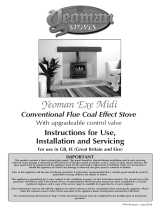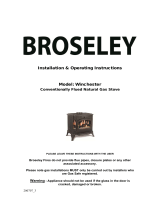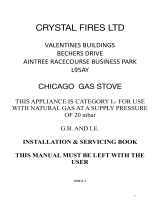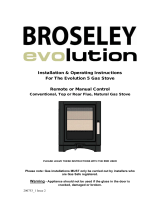Stovax F40 is a conventional flue coal effect stove with a fully automatic battery operated gas control which can be lit using the hand set or touch pad. Flame height can be adjusted and the stove also features an LED display that provides information such as temperature, clock and battery status. The F40 Avanti is suitable for use in GB and IE using Natural Gas at a supply pressure of 20mbar or LPG at a supply pressure of 28mbar (Butane) or 37mbar (propane).
Stovax F40 is a conventional flue coal effect stove with a fully automatic battery operated gas control which can be lit using the hand set or touch pad. Flame height can be adjusted and the stove also features an LED display that provides information such as temperature, clock and battery status. The F40 Avanti is suitable for use in GB and IE using Natural Gas at a supply pressure of 20mbar or LPG at a supply pressure of 28mbar (Butane) or 37mbar (propane).




















-
 1
1
-
 2
2
-
 3
3
-
 4
4
-
 5
5
-
 6
6
-
 7
7
-
 8
8
-
 9
9
-
 10
10
-
 11
11
-
 12
12
-
 13
13
-
 14
14
-
 15
15
-
 16
16
-
 17
17
-
 18
18
-
 19
19
-
 20
20
-
 21
21
-
 22
22
-
 23
23
-
 24
24
Stovax F40 is a conventional flue coal effect stove with a fully automatic battery operated gas control which can be lit using the hand set or touch pad. Flame height can be adjusted and the stove also features an LED display that provides information such as temperature, clock and battery status. The F40 Avanti is suitable for use in GB and IE using Natural Gas at a supply pressure of 20mbar or LPG at a supply pressure of 28mbar (Butane) or 37mbar (propane).
Ask a question and I''ll find the answer in the document
Finding information in a document is now easier with AI
Related papers
-
Stovax 5 User manual
-
Stovax Stove Range User manual
-
Stovax Huntingdon 30 User manual
-
Stovax 705088 User manual
-
Stovax 8517-P8517 User manual
-
Stovax Stockton2 Small Gas Stoves & Medium Gas Stoves Operating instructions
-
Stovax GAZCO Linea Balanced Flue Convector Fire User manual
-
Stovax Studio 22 User manual
-
Stovax Stockton 8573 User manual
-
Stovax Designio2 Steel User Instructions
Other documents
-
 Yeoman PR1145 User manual
Yeoman PR1145 User manual
-
Roberts Revival 250 (R250)( Rev.1) User guide
-
Focal Point Flueless Gas Stove User manual
-
 Broseley Winchester Gas Stove Installation guide
Broseley Winchester Gas Stove Installation guide
-
Numatic TTB1840G Owner Instructions
-
Focal Point Centurion Flueless Stove User manual
-
 crystal fires Chicago Installation & Servicing Book
crystal fires Chicago Installation & Servicing Book
-
AGA Classic Range Gas Owner's manual
-
Focal Point CENTURION User manual
-
 Broseley Evolution 5 Gas Stove Installation guide
Broseley Evolution 5 Gas Stove Installation guide



























